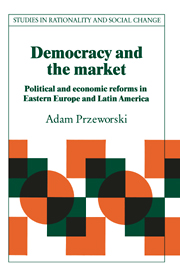2 - Transitions to democracy
Published online by Cambridge University Press: 05 June 2012
Summary
Introduction
The strategic problem of transition is to get to democracy without being either killed by those who have arms or starved by those who control productive resources. As this very formulation suggests, the path to democracy is mined. And the final destination depends on the path. In most countries where democracy has been established, it has turned out to be fragile. And in some countries, transitions have gotten stuck.
The central question concerning transitions is whether they lead to consolidated democracy, that is, a system in which the politically relevant forces subject their values and interests to the uncertain interplay of democratic institutions and comply with the outcomes of the democratic process. Democracy is consolidated when most conflicts are processed through democratic institutions, when nobody can control the outcomes ex post and the results are not predetermined ex ante, they matter within some predictable limits, and they evoke the compliance of the relevant political forces.
Note that a breakdown of an authoritarian regime may be reversed, as it was in Czechoslovakia in 1968, in Brazil in 1974, and in Poland in 1981, or it may lead to a new dictatorship, as in Iran and Romania. And even if the outcome is not the old or a new dictatorship, transitions can get stuck somewhere along the way in regimes that limit contestation or suffer from a threat of military intervention. Finally, even if democracy is established, it need not be consolidated.
- Type
- Chapter
- Information
- Democracy and the MarketPolitical and Economic Reforms in Eastern Europe and Latin America, pp. 51 - 99Publisher: Cambridge University PressPrint publication year: 1991
- 2
- Cited by

